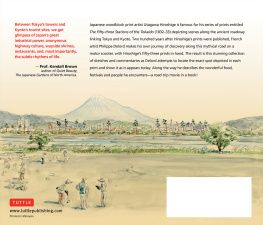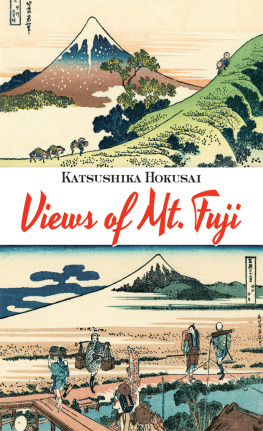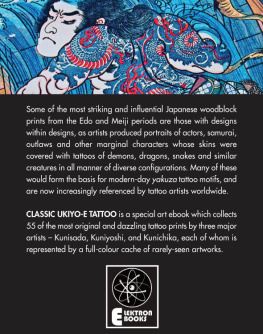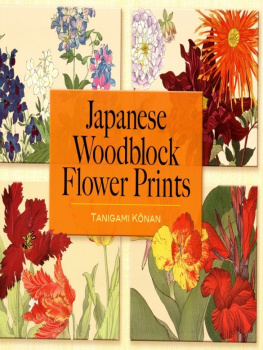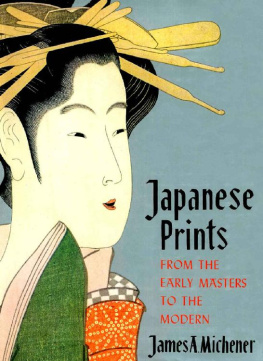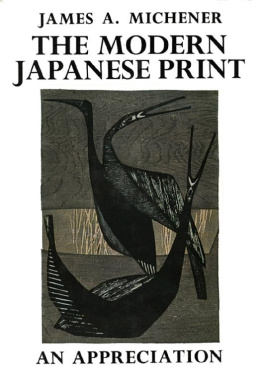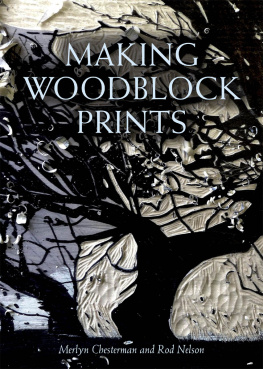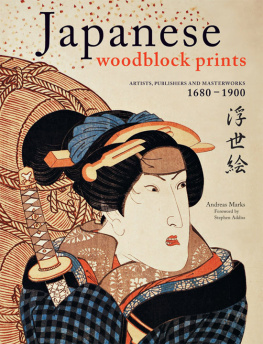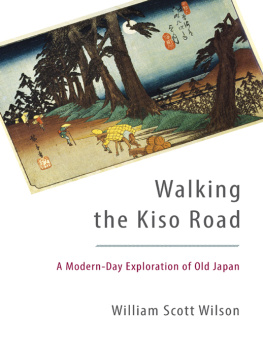IN THE FOOTSTEPS OF HIROSHIGE
This book showcases drawings made between 2014 and 2016 during trips
I made along the historic Tokaido road, atop a 125 cc scooter. This road,
stretching for three hundred miles (five hundred kilometers), dates back
to the eleventh century, connecting Tokyo (formerly Edo) to Kyoto.
My goal was to follow the path of the ancient road to see if I could
find the locations depicted in the series of prints The Fifty-Three Stations
of the Tokaido , the best-known work of renowned artist Utagawa
Hiroshige (17971858), first published from 183233. As I tried to
capture the modern-day versions of these scenes in my own sketches and
watercolors, I found myself in a world floating between past and present,
where fabulous images from the Edo period and contemporary Japan
blended together. This book is a record of that journey.
The Fifty-Three Stations of the Tokaido Road
A Brief History of the Tokaido Road
During the Edo period (16031868), five main roads crisscrossed
Japans main island of Honshu. These five roads were collectively
called the Gokaido (lit., five roads). They all started from the newly
established capital, Edo, todays Tokyo. Two roads went north: the
Nikkokaido and the Oshukaido. Three roads went south to connect to
Kyoto: the Nakasendo and the Koshukaido went through the inland
mountains whereas the Tokaido, the Eastern Sea Road more or less
followed the Pacific coast.
THE FIFTY-THREE STATIONS OF THE TOKAIDO
The Tokaido was at its busiest during the Edo period. In 1603,
Tokugawa Ieyasu, the first shogun, had gained control of the whole of
Japan. Edo became the new capital of the country, seat of his military
government, the bafuku . The former capital, Kyoto, was still regarded
as the imperial capital. The Tokaido became the main thoroughfare for
traffic between these two administrative cities for feudal lords and their
retinues, as well as for pilgrims visiting religious sites at Ise, near Kyoto.
The word Tokaido is made up of three characters:
TO = east
KAI = sea
DO = road
So Tokaido means the Eastern Sea Road, in other
words, the Pacic Ocean Road.
Shanks Mare by Jippensha Ikku,
English edition, 2001,
Tuttle Publishing.
Hiroshige designed at
least eleven woodblock
print series on the
subject of the Tokaido.
Three versions of 41st
station: Miya , are shown
here: right, published by
Hoeido; below right
published by Sanoki;
below, published
by Koeido.
Tokaidochu Hizakurige,
Japanese edition of Shanks
Mare , 2013, published by
Iwanami Shoten.
Laborers would also use the road to commute between large cities and
provincial towns. Its path was well marked and controlled by guards who
monitored safety along the road. At regular intervals were stations:
places where travelers could find inns and restaurants. Many guides to
famous places ( meisho-ki and meisho-ku ) were published at the time.
These travel books would indicate distances between stations, local
specialties, as well as the prices of lodgings, and the locations of porters
and toll booths.
At the beginning of the Edo period, the first Tokugawa shogun,
Ieyasu, fixed the number of stations along the Tokaido at fifty-three.
Along the roughly three hundred miles (five hundred kilometers)
separating Edo from Kyoto there would be a station every five miles
(eight kilometers) on average.
TWO ICONIC BOOKS ABOUT THE TOKAIDO
During my own trip along the vestiges of the old Tokaido road, I carried
two books in my luggage. One was Shanks Mare , by Jippensha Ikku, first
published in serial form between 1802 and 1822. This comedy, largely
inspired by meisho-ku guidebooks of the time, relates the picaresque
adventures and misadventures of two pals who travel the Tokaido on
foot. The characters are Yajirobei and Kitahachi, better known in Japan
by the nicknames Yaji-san and Kita-san, or the contraction Yajikita to
refer to both of them.
The other book I brought with me was the actual starting point for
this project; it contains the famous series of woodblock prints The Fifty
Three Stations of the Tokaido by Utagawa Hiroshige. The best-known
version of this collection of prints was published from 183233 by the
Japanese publisher Hoeido. The prints depict the fifty-three stations of
the road season after season, and linger with humor and empathy on the
numerous characters making their way along the thoroughfare. From
1832 until 1857, Hiroshige would design at least eleven different versions
of this set of prints.
THE TOKAIDO ROAD TODAY
The Edo period ended in 1868, and the old Tokaido road, illustrated by
master printmakers such as Hiroshige, has almost vanished in todays
modern landscape. Still, the Tokaido exists in a contemporary shape.
Even though the stretch of coast between Tokyo and Kyoto is heavily
built up, traces of the old road can still be found, meandering past
commercial and industrial zones, rice fields, tract houses, elevated
freeways and waterfront docks.
In contemporary Japan, both National Route 1 and the Tokaido
shinkansen bullet train line follow the route of the old Tokaido road.
Todays travelers may take these urbanized routes without giving a
thought to the original thoroughfare. But during my first trip along this
route, I would unexpectedly stumble upon reminders of the past, in
the form of a memorial plaque, a historical sign, or a section of the old
route preserved for the pleasure of tourists.
An old French map of the Tokaido road
Traveling the Tokaido by Shinkansen
I am on the high-speed shinkansen bullet train, which takes me from
Tokyo to Kyoto. The Tokaido railway line more or less follows the path
of the East Sea Road from which it took its name.
The ticket price is astronomical. Seats are occupied by business
men in custom-made suits, by women laden with delicate parcels,
by English-speaking foreigners with goatee beards. The conductor is
obsequious. He thanks passengers in a well-rehearsed speech and his
bowing upon leaving the train car is deferential.
Through windows shaped like a planes portholes, a disjointed
landscape goes by. A series of visual events stretches from one high
voltage pylon to another above tract-house suburbs: rice fields border
factories; expressways, tortuous and elevated, fly above strip malls.
Over there, on top of a hill, a temple and its glossy roof tiles emerge
from dense vegetation. A trickle of water flows lazily into a too-large
river bed, walled in by high concrete dikes.
Suddenly the eye catches a spark of light in the distance... Its the
sea, a myriad of scintillations behind a barrier of chimneys, bridges and
docks. Everything is in a topsy-turvy rush. How to recognize the thread
of the Tokaido within this urban maze? Could there still be traces of it
intact within this tangled landscape?
I go back to the two books on the table at my seat.
The first book is Shanks Mare by Jippensha Ikku. Both comic novel
and travel guide, it tells of the picaresque trials and tribulations of two
friends, Yajirobei and Kitahachi, who set off along the Tokaido road in
order to escape creditors from the eastern capital, Edo.

